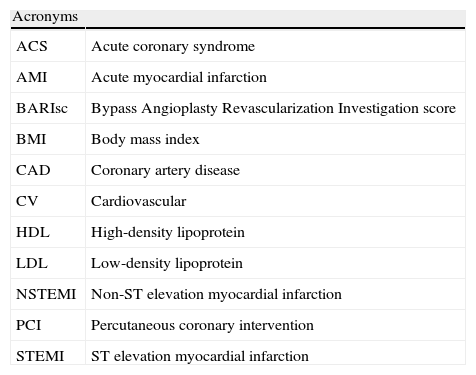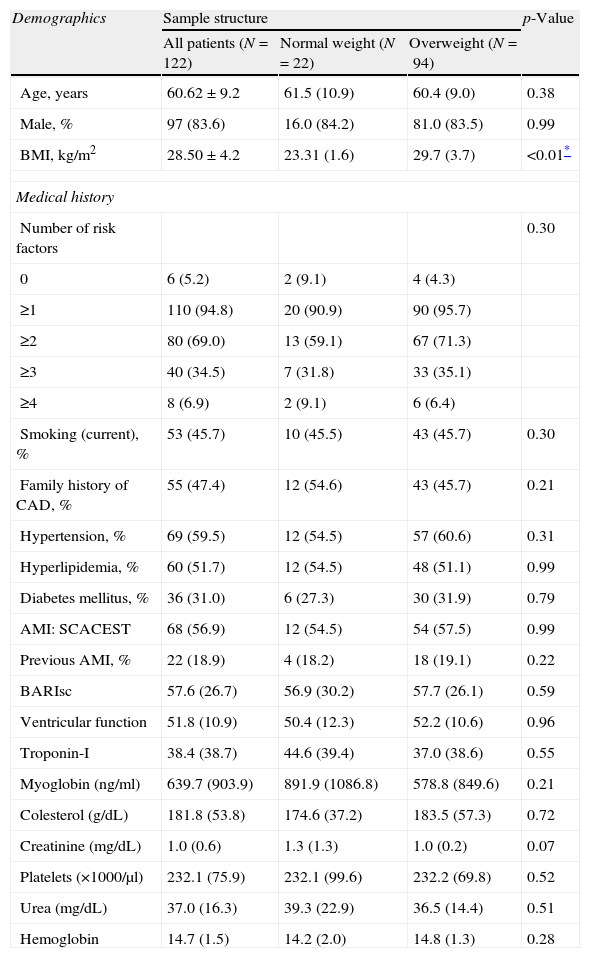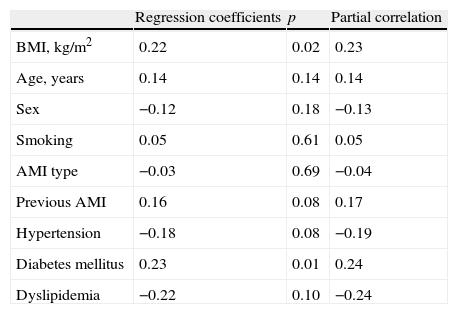Whilst traditional studies have shown that obese individuals are at a higher risk of cardiovascular events compared to lean subjects, recent studies in patients with acute myocardial infarction (AMI) have suggested that obesity may exert protective effects (the “obesity paradox”). We sought to assess the relationship between body mass index (BMI) and the BARI score (BARIsc), a validated tool used to assess myocardium at risk, in patients with acute coronary syndrome.
Patients and methodsParticipants were 116 consecutive patients (mean age, 60.6 years; 97 men) with AMI (68 ST elevated myocardial infarction, STEMI; 48 non-ST elevated myocardial infarction, NSTEMI). Demographics, BMI, risk factors, biochemistry data, left ventricular function, angiographic data and the BARIsc were assessed in every patient.
ResultsMultiple linear regression analyses showed that BMI significantly correlated with BARIsc; β=.23, p<0.02. This was found only in the overweight/obese patients, β=.27, p<0.01, but not in patients with normal BMIs, β=0.08, p=0.71.
ConclusionsAn increased body weight is associated with an increased area of myocardium at risk in patients with ACS.
Algunos estudios han demostrado que los pacientes obesos presentan un mayor riesgo cardiovascular, pero estudios más recientes en pacientes con infarto agudo de miocardio (IAM) han sugerido que la obesidad puede ejercer un efecto protector (efecto conocido como la “paradoja de la obesidad”). Hemos examinado la relación entre el índice de masa corporal (IMC) y la puntuación ofrecida por el BARI (BARIsc), una herramienta validada para determinar la cantidad de miocardio en riesgo en los pacientes con síndrome coronario agudo.
Pacientes y métodosSe incluyeron 116 pacientes de forma consecutiva (edad media, 60.6 años; 97% varones) con IAM (68 con un síndrome coronario agudo con elevación de ST [SCACEST], y 48 con síndrome coronario agudo sin elevación de ST [SCASEST]). En todos ellos se determinaron las variables demográficas y analíticas, los factores de riesgo cardiovascular, el IMC, la función ventricular, los datos angiográficos, y el BARIsc.
ResultadosEl análisis de regresión lineal múltiple mostró que el IMC se correlacionaba significativamente con el BARIsc, β=,23; p<0,02. Esto se demostró únicamente en los pacientes con sobrepeso u obesidad, β=,27; p<0,01, pero no en los que presentaban IMC normal β=0,08; p=0,71.
ConclusionesEl aumento de peso se asocia a la cantidad de miocardio en riesgo en pacientes que con un SCA.
Article
Diríjase desde aquí a la web de la >>>FESEMI<<< e inicie sesión mediante el formulario que se encuentra en la barra superior, pulsando sobre el candado.

Una vez autentificado, en la misma web de FESEMI, en el menú superior, elija la opción deseada.

>>>FESEMI<<<













